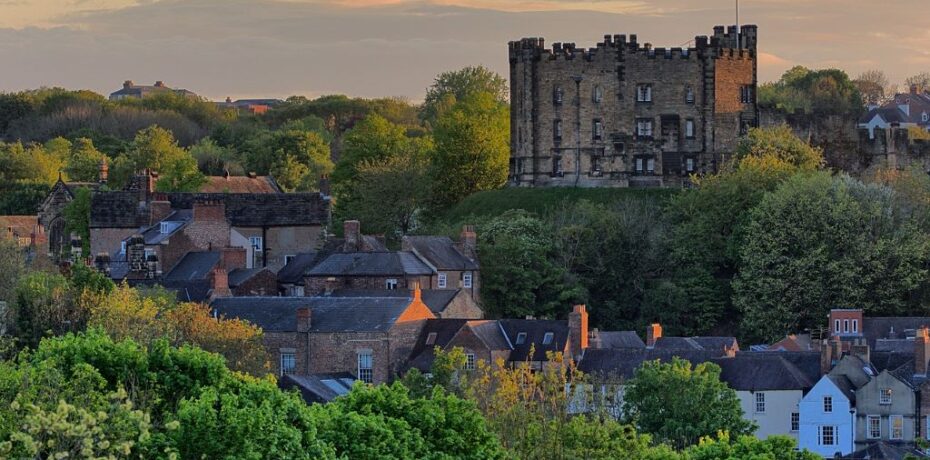The Subplot
The Subplot | Innovation, Credit Suisse, office take-up
Welcome to The Subplot, your regular slice of commentary on the business and property market from across the North of England and North Wales.
THIS WEEK
- Durham dreams: could the city follow Oxford and Cambridge into big-league innovation property development?
- Elevator pitch: your weekly rundown of who and what is going up, and who is heading the other way
DURHAM, THE NEW CAMBRIDGE?
Good things come to those who wait
Durham’s 148-acre Innovation District could be a game changer, potentially mirroring the way science and innovation have transformed economic prospects in Oxford and Cambridge. But be patient: this will take ages.
Every journey begins with a single step, and in this case it’s a nice walk across some football pitches en route from Durham County Hall, across Durham’s Aykley Heads recreation ground, to the former HQ of Atom Bank. That’s because a few weeks ago the county council bought the 40,000 sq ft Rivergreen Centre from Adderstone Group for £11m. Staff will relocate and the wrecking ball will come to visit old County Hall. In the process the way is cleared for a 148-acre innovation district, one of the largest of its kind in the UK.
Ambitions
This is big news. It could be transformational. Leeds has its 370-acre Innovation Arc. Manchester has its 583-acre Innovation Corridor topped off by the £1.7bn ID Manchester scheme, and at right angles to that is Cheshire’s 546-acre Science Corridor, starting (or ending) at Alderley Park. Likewise the County Durham idea packages a vast acreage, and some useful development opportunities.
Durham University, founded in 1838 and England’s third, fourth, or fifth oldest depending how you count these things, is the obvious place to grow. It’s timely, too. This week, Knight Frank reported that life science floorspace in the Oxford-Cambridge arc was five times over-subscribed. The aim is to import a little of that excitement into the North East.
TL;DR
Arriving at today hasn’t been easy. A short step across the park comes after an extremely long journey. The idea of something big at Aykley Heads – core of the innovation district – emerged before 2012. It then got mired in plans to relocate, rebuild, and otherwise re-think County Hall, a tale of fantastic intricacy.
Long story short: what was by 2020 a plan to move the council to a new-build block at The Sands in Riverside and build another speculative office block got nixed when Labour lost power in May 2021. A coalition composed of everyone else took control, and the policy changed. The Sands was sold to Durham Business School, the council has wound up at Rivergreen with the prospect of taking space at Plot C, and Aykley Heads is now ready for development. It’s a 400,000+ sq ft, 15-acre opportunity down the road from the 231,000 sq ft Milburngate office development. The full story is summarised in a council report.
Not quick
Or so everyone hopes. But this is a marathon, not a sprint. Results will take well into the next economic cycle. The council is now hunting for “a strategic partner who brings the skills, networks, investment, and expertise” to make this work. It will take a year or so to sort this out. The council’s cabinet was told: “The outcome of the market procurement process will be reported to cabinet late in 2024, along with a [full business case] to inform a decision on whether to progress the proposal for a Durham Innovation District at Aykley Heads.” Staff will leave County Hall for Plot C in early 2024, the rest to Rivergreen in spring 2025. The demolition of County Hall will take two years, completed by spring 2027.
More money?
So don’t start popping the corks yet. Getting some big ticket support will be vital (“note that there may be further public investment needed to deliver the development at Aykley Heads,” councillors were told). Earlier this month a bid was submitted to the Treasury for investment zone status covering the 19 buildings and 400,000 sq ft commercial floorspace at Aykley Heads along with a second, science-led site at NETpark in Sedgefield. NETpark is in the midst of a 232,000 sq ft extension, led by the county council with contractor Kier.
Dating dilemmas
Finding a partner is going to be tricky because these things always are. Subplot understands that the aim is for a 50:50 joint venture partner to develop the site with the county council. The lucky party will also be tasked with helping to build the ecosystem of the entire innovation district.
Conversations with five potential partners will turn into conversations with no more than three as part of what’s called a competitive dialogue. The difficulty – as ever – is that potential partners have different skills, some have money, some don’t, making the 50:50 JV idea aspirational at best. And the whole process can stretch over several economic cycles, which can screw even the most iron-clad corporates and investors. A joint venture agreement could be signed in 2025, all being well.
The prize
But all that is for the future. Durham ought to have been punching its weight in this market long ago, but lack of city centre space made that impossible. The Aykley Heads site could change that. There’s a massive potential win here if bad timing and political upsets don’t mess it up.
 ELEVATOR PITCH
ELEVATOR PITCH
Going up, or going down? This week’s movers
Office property values continue to fall but there may be room for optimism when it comes to lettings. Doors closing, going down.
 Swiss cheese in Leeds
Swiss cheese in Leeds
Credit Suisse was yanked out of a vortex of chaos in March by local banking rival UBS. The new bosses are now in the process of winding down parts of the Credit Suisse property portfolio (the head of asset management left in June). Eyes turn to the £3bn Credit Suisse Real Estate Fund International, a venture with 82% of its assets in office property, and £364m of it in the UK.
Leeds is a vital testing ground. Knight Frank and JLL are selling two buildings: One Leeds City Office Park, 56,300 sq ft with a book valuation of £9.6m; and 26 Whitehall Road, 122,000 sq ft valued at £28.5m.
Not for sale – yet – is Princes Exchange, 108,500 sq ft of offices built in 1999, bought in 2016 for £44m and now with a book value of £29.1m. Rental income is about £1.2m a year. Numbers come from the fund’s accounts.
Also not yet for sale is the site of the former Eversheds office at 70 Great Bridgewater Street, Manchester. The fund’s accounts record a purchase price of £32.7m and a latest valuation of £22.7m. That’s a lot of backwards movement. Consent for a 120,000 sq ft rebuild was secured in 2021, with a Q4 2023 completion date.
A good time to sell offices? Manifestly not. But UBS fund managers will have their Swiss fingers crossed, hoping that flogging offices one by one will yield better results than a grand portfolio sale. Hmmm.
 Suburban offices in Manchester
Suburban offices in Manchester
After a flat first half, Manchester’s office market picked up speed in the summer. The city centre market is now, more or less, back to where it usually is with cumulative total of 721,000 sq ft. If this pace continues – and there’s no reversion to the first-half trend – the core might hit 1m by the end of the year, which would cheer everyone up enormously. It is worth noting that Central London, too, had a good Q3 after a thin first half, which suggests this is a marco-economic issue and not something uniquely Mancunian.
But the really good news story might be out-of-town where 463,000 sq ft was let in South Manchester’s business parks this year. That’s big news because it means the market has already reached its 2022 annual total and won’t have any trouble beating the 497,000 sq ft recorded in 2021. Look at the change in the relative size of markets, too. In 2022 the South Manchester market was 38% the size of the city centre market. In 2021, it was 50%. This year it’s likely to be higher still. Contrary to some hot takes, the out-of-town market is far from dead – and the high-cost, high-spec city centre market far from the only show in town.
Get in touch with David Thame: david.thame@placenorth.co.uk





To build a success industry it has to come from the bottom – that means low taxes of investment , secure supply of cheap and reliable energy and a very favourable planning policy on not just building science parks, but on housing, infrastructure, airports etc! Put these founding building blocks in and growth and innovation will come
By Stuart wood